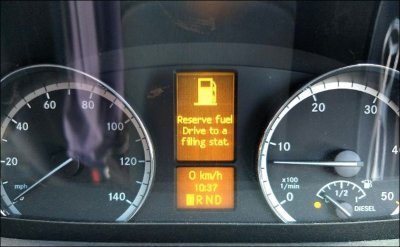We have probably all gambled on running with the light on in the hope that it will get us to the nearest petrol station , home or wherever , and occasionally got it wrong ; the fuel reserve in the tank gives you that second chance to actually get somewhere after you run it too low . Besides , the Ponton had a warning light that came on well before the fuel ran out on the primary pipe , so the tank reserve really was a second chance .What's the advantage of that over the modern low fuel light and warning message plus remaining range display?
Fuel gauges can all be temperamental - I've seen it many times : park up at night with just under a quarter tank showing , and in the morning when you start up the light is on and the gauge is in the red . Can vary by facing uphill/downhill and range remaining can vary by how you're driving , besides none of my cars have that feature .
I always carry a can in case of running out , but the reserve tap in older vehicles was very handy , and if you ran out on the primary pipe , you KNEW you needed to get to a petrol station sharpish .

